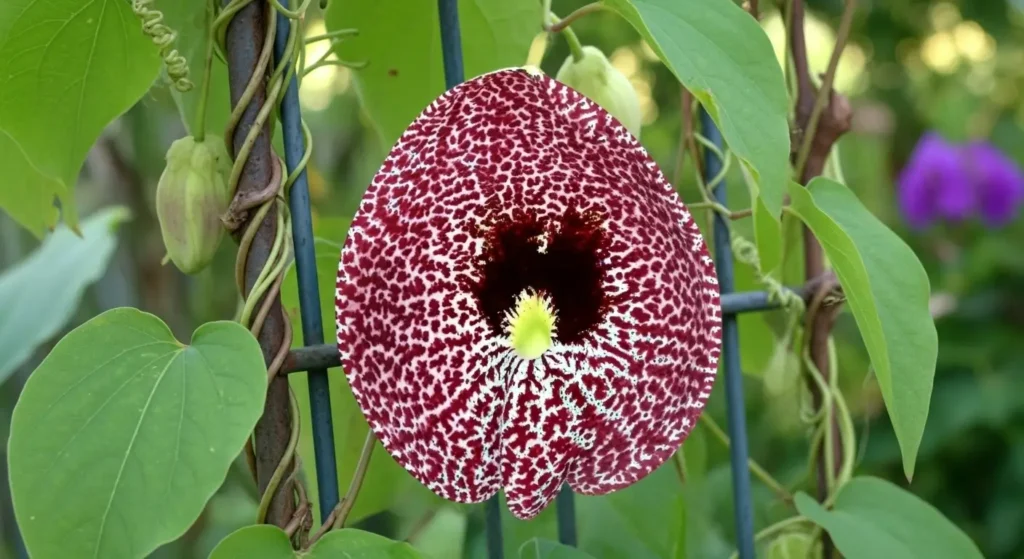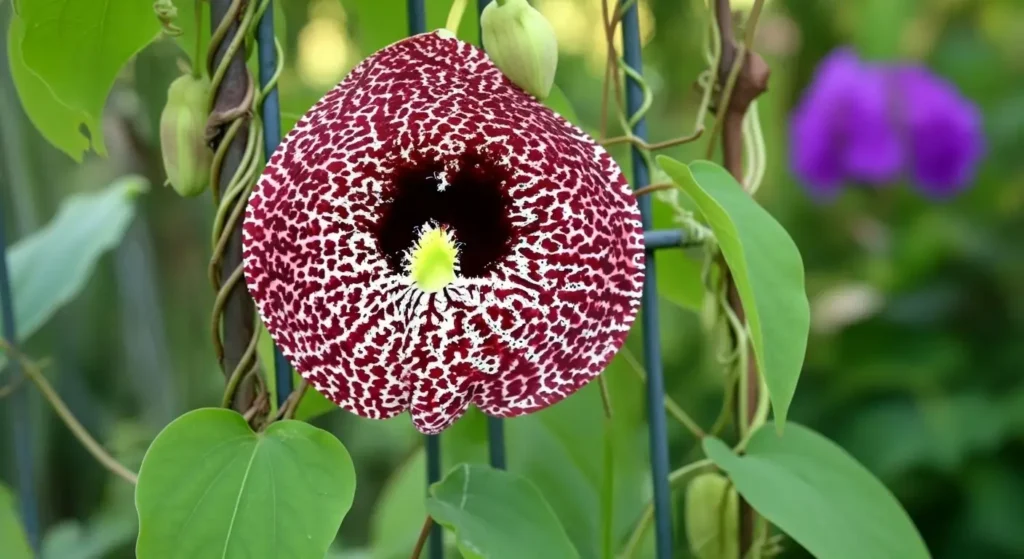
In This Article
The duck flower, scientifically known as Aristolochia grandiflora, is an exotic tropical vine famous for its bizarrely shaped blooms. This plant produces one of the world’s largest flowers, which can reach up to 12 inches across. Native to Central and South America, particularly Panama and Brazil, this climbing vine features unique flowers that resemble a duck’s head. While it requires moderate care and attention to humidity, the duck flower rewards growers with its spectacular and conversation-starting blooms that smell distinctly musky.
Plant Care Card
| Attribute | Details |
|---|---|
| Common Name | Duck Flower, Pelican Flower |
| Botanical Name | Aristolochia grandiflora |
| Family | Aristolochiaceae |
| Plant Type | Perennial tropical vine |
| Mature Size | 10-20 feet long (climbing) |
| Sun Exposure | Bright indirect light to partial shade |
| Soil Type | Well-draining, rich, loamy |
| Soil pH | 6.0-7.0 (slightly acidic to neutral) |
| Hardiness Zones | 10-11 (USDA) |
| Native Area | Central and South America |
| Toxicity | Toxic to pets and humans |
Duck Flower Care
This tropical vine requires moderate attention and thrives with consistent warmth and humidity levels. The following sections will guide you through light requirements, watering schedules, soil needs, and more.
Light
The duck flower thrives in bright indirect light but can tolerate partial shade conditions. In its native rainforest habitat, this vine grows under the canopy where it receives filtered sunlight. Too much direct sun will scorch the leaves and cause them to yellow or brown. Place your duck flower near an east or west-facing window where it gets morning or late afternoon sun. If growing outdoors, position it in a spot that receives dappled shade throughout the day.
Soil
This tropical vine needs rich, well-draining soil that retains some moisture without becoming waterlogged. A mix that includes organic matter works best for healthy root development. You can create an ideal mix using equal parts potting soil, peat moss, and perlite or coarse sand. According to University of Illinois Extension, proper drainage prevents root rot and other moisture-related issues. Some growers add compost or aged bark to increase organic content and improve soil structure.
Water
Water your duck flower when the top 2-3 inches of soil feel dry to the touch. This plant prefers consistent moisture but absolutely hates sitting in soggy soil. During the growing season from spring through summer, you’ll likely water every 4-7 days depending on temperature and humidity. Check the soil regularly by inserting your finger into the potting mix. If it feels dry at depth, it’s time to water thoroughly until excess drains from the bottom. Similar watering needs apply to Krimson Queen Hoya, another tropical plant that appreciates consistent moisture. Reduce watering frequency in fall and winter when growth naturally slows down.
Temperature and Humidity
Duck flowers thrive in warm temperatures between 65-85°F and require high humidity levels above 60%. These tropical vines struggle in cold conditions and will drop leaves if temperatures fall below 55°F. Keep your plant away from cold drafts, air conditioning vents, and heating units that dry the air. Increase humidity by misting the leaves daily, placing the pot on a pebble tray filled with water, or using a humidifier nearby. Grouping it with other tropical plants like Anthurium Clarinervium also creates a more humid microclimate naturally.
Fertilizer
Feed your duck flower with a balanced liquid fertilizer diluted to half strength every 2-4 weeks during spring and summer. This supports vigorous vine growth and encourages blooming throughout the active growing season. Reduce feeding to once monthly in fall and stop fertilizing completely during winter dormancy.
Propagating Duck Flower

The best time to propagate this exotic vine is during spring and summer when growth is most active.
Propagating by Stem Cuttings
Taking stem cuttings is the most reliable propagation method for duck flowers.
Materials needed:
- Clean, sharp pruning shears or scissors
- Small pot with drainage holes
- Well-draining potting mix
- Rooting hormone powder (optional but recommended)
- Clear plastic bag or humidity dome
Steps:
- Select a healthy stem section that’s 4-6 inches long with at least two sets of leaves. Make your cut just below a leaf node using sterilized shears.
- Remove the lower leaves and dip the cut end in rooting hormone powder to encourage faster root development.
- Plant the cutting in moist potting mix, burying at least one node below the soil surface. Firm the soil gently around the stem to provide support.
- Cover the pot with a clear plastic bag or humidity dome to maintain high humidity levels. Place in bright indirect light and keep the soil consistently moist but not waterlogged.
You’ll typically see new root growth within 3-4 weeks. Once roots are established and new leaf growth appears, gradually remove the humidity cover and treat as a mature plant. Similar to Bougainvillea, stem cuttings root reliably when provided with warmth and humidity.
Potting and Repotting Duck Flower

Repot your duck flower every 1-2 years or when roots start growing through the drainage holes. This vine grows rapidly during the growing season and can quickly become rootbound. Choose a pot that’s 2-3 inches larger in diameter than the current container. According to Royal Horticultural Society, spring is generally the best time to repot as plants start into growth. Carefully remove the plant from its old pot and gently loosen the root ball. Always select pots with drainage holes to prevent water accumulation at the bottom.
Common Pests and Diseases
Like most tropical houseplants, duck flowers can occasionally attract pests when stressed or growing in poor conditions.
Spider Mites
Look for fine webbing on leaf undersides and tiny moving dots on the foliage. These pests thrive in dry conditions and cause stippling or yellowing of leaves. Treat infestations by spraying the plant with insecticidal soap or neem oil, making sure to coat all leaf surfaces thoroughly.
Mealybugs
These white, cottony pests cluster at leaf joints and along stems where they suck plant juices. Remove mealybugs with a cotton swab dipped in rubbing alcohol, or spray with neem oil. Repeat treatments weekly until the infestation is completely gone.
Scale Insects
Scale appears as small brown or tan bumps stuck to stems and leaf undersides. According to Penn State Extension, these armored pests are difficult to remove but can be scraped off gently. Follow up with horticultural oil applications to kill any remaining crawlers.
Aphids
Small green, black, or brown insects cluster on new growth and flower buds, causing distorted leaves. Spray aphids off with a strong stream of water or treat with insecticidal soap.
Common Problems With Duck Flower
Yellow Leaves
Yellowing leaves are most commonly caused by overwatering, which leads to root rot and nutrient deficiency. Allow the soil to dry out more between waterings and check that your pot has adequate drainage holes. Another cause is insufficient nutrients, especially nitrogen deficiency during the growing season. Similar issues occur with Croton plants, another tropical plant sensitive to watering schedules.
Brown Leaves or Brown Leaf Tips
Low humidity is the primary culprit behind brown, crispy leaf edges on duck flowers. These tropical vines need high moisture in the air to thrive indoors. Increase humidity immediately using a humidifier, pebble trays, or frequent misting. Poor water quality containing chlorine or fluoride can also cause brown tips.
Drooping or Wilting Leaves
Wilting usually signals watering problems, either too much or too little. Check the soil moisture immediately by feeling several inches deep into the potting mix. If bone dry, water thoroughly and the plant should perk up within hours. If the soil is soggy, you’ve likely overwatered and may be dealing with root rot.
No Blooms
Duck flowers require mature growth, adequate light, and proper care before they’ll produce their spectacular blooms. Young plants may take 2-3 years to reach blooming maturity, so patience is essential. Insufficient light is another common reason for lack of flowers. Make sure your plant receives bright indirect light and consistent fertilization during the growing season. Some growers find that a slight reduction in watering during early spring can trigger blooming in mature plants.
FAQ
What does the duck flower do?
The duck flower produces spectacular blooms resembling a duck’s head and attracts pollinators with its musky scent. As an ornamental tropical vine, it creates dramatic visual interest on trellises and arbors. The flowers can reach impressive sizes up to 12 inches across when mature.
How long does the duck flower take to work?
From planting to first bloom, duck flowers typically take 2-3 years to reach maturity and produce flowers. Once established, individual blooms develop over several weeks and can last 3-7 days when fully opened. Young plants focus energy on vine growth before flowering begins.
What does a duck flower smell like?
The duck flower emits a strong, musky odor often described as resembling rotting meat or carrion. This unpleasant scent attracts flies and other pollinators in its native habitat. The smell is most intense when blooms first open and fades slightly over several days.
Is the duck flower safe to grow at home?
While fascinating to grow, duck flowers contain toxic compounds and should be kept away from pets and children. According to ASPCA, plants in the Aristolochia family can be harmful if ingested. Similar to Lipstick plants, it’s best to position them in locations where curious pets cannot reach them.
